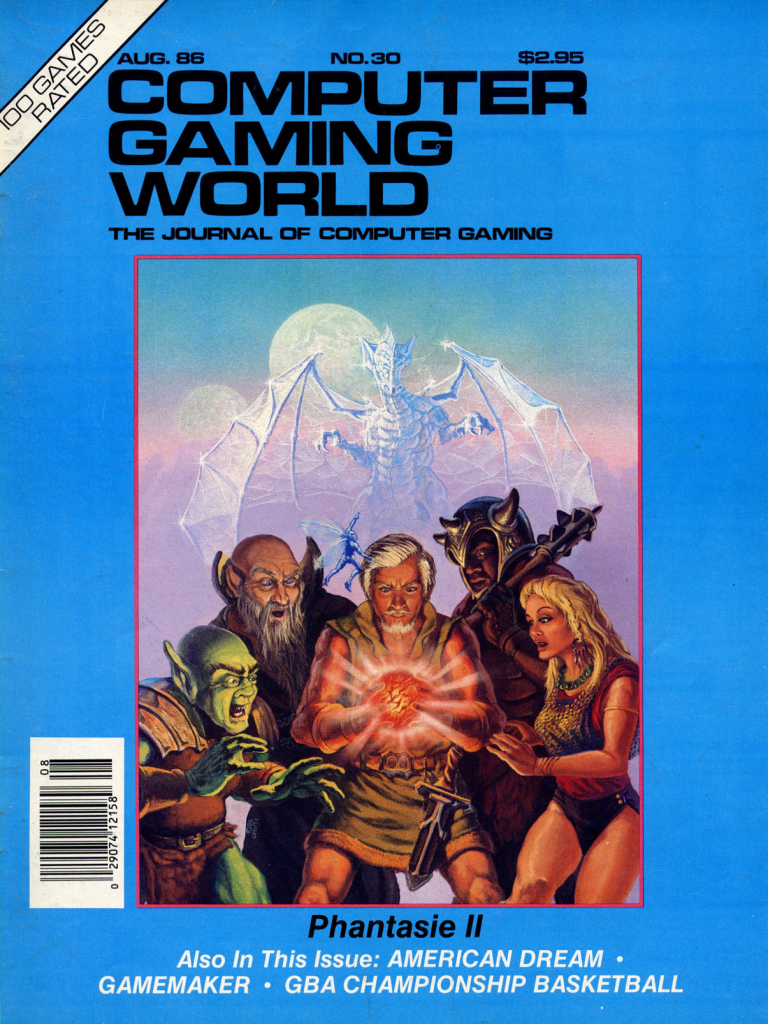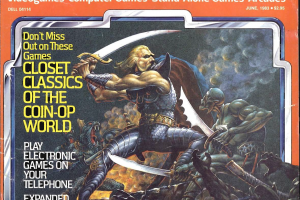In this ongoing Armchair Arcade series, I take a look at random videogame- and computer-centric magazines from years past. I’ll point out particularly interesting content within each magazine and provide commentary from the perspective of what we know now. Whenever possible, I’ll provide direct links to PDF scans of the material so you can follow along.
Today’s feature, 001, is on the August 1986 issue of Computer Gaming World, which is issue 30.

Computer Gaming World, 08/1986 (cover)
Starting with the cover, I know I’m already in for a treat as artwork from SSI’s Phantasie II box is featured. The Phantasie series was my first proper introduction to Dungeons & Dragons pen and paper-style role-playing on a computer – in this case my Commodore 64 (C-64) – and it left a lasting impression. I also had fun with the other game mentioned on the cover, GBA Championship Basketball and dabbled with Activision’s Gamemaker, although I never ended up making much with it. I’m not sure what American Dream is, so I’ll be curious to find out. In any case, there’s a lot to be said for Computer Gaming World‘s (hereafter, CGW) cover design, as the artwork against the blue background and clean lettering is particularly classy. It’s understated in a way that today’s magazines simply wouldn’t be able to attempt.
On page 5, in the Taking a Peek column (short previews), a mention is made of a “nice new entry into the ranks of chess programs,” called Chessmaster 2000, available for Apple II, Atari 8-bit, C64/128, Amiga, and Atari ST (and as was normal for the time, suggesting to Circle Reader Service # 23 on the magazine’s advertiser’s card to potentially get more information mailed to you). Chessmaster was of course a long running multi-platform series that made it into the modern era, and was arguably the most popular chess simulation series of all time. Ubisoft last held the rights, but it’s unclear to me who owns them now. Either way, it’s not possible to play a version of the game on a modern platform, which is a pity because I always liked the core concept of playing against computer opponents with different personalities rather than just a generic opponent. The latest version I own is for the Microsoft Xbox 360, followed by versions for the Nintendo DS and Sony PlayStation 2. While I still can play on any of those systems any time I want, I’d much rather have a version for a newer platform, and especially on the PC side.
Also mentioned on page 5 is The American Challenge, a match race sailing simulation for Apple II and IBM (and compatible) computers. Sailing simulations were definitely a thing at one time, although I can’t think of any prominent titles these days.
On page 10 is an ad for Dragon Fire II: The Dungeonmaster’s Assistant, which works on IBM PCs and compatibles, C-64, and Apple II. The only other major commercial dungeon master assistant I was aware of was the stuff from SSI during the Gold Box era. I suppose the advantage of this one is that it was meant to be somewhat generic and work with most pen and paper role playing systems. It’s an interesting artifact even if I’ve never heard of it before myself.

Computer Gaming World, 08/1986 (page 12)
On page 12 is American Dream: The Management Simulation from Blue Chip Software (BC) for the IBM PC and compatibles. Now I know what it is. I’m intimately familiar with BC’s earlier management simulations like Millionaire and always liked the padded vinyl packaging (later releases went to cardboard), but perhaps because this particular game was not multi-platform like the others (not surprising since this one is not strictly text-based like the earlier games) relegated it to greater obscurity. As usual, BC wasn’t shy about pricing their software sky high, this one at $124.95 (about $272.06 in today’s dollars!). Presumably the target audience was high powered business executives.
Page 16 has the Phantasie II review (original Apple II version) by the infamous Scorpia. She makes good points, in that even at the time I thought Phantasie II was really just a bug fixed minor update of the first Phantasie game. I still loved it, however, and the concluding paragraph of the review more or less agrees:
“Bottom line: Although flawed in certain aspects, Phantasie II is an interesting, and overall good, game of the RPG type; if you liked the original Phantasie, you won’t want to miss this one.“
Page 20 has a rather breathless review of GBA Championship Basketball: Two On Two. It was a favorite of mine too, only surpassed a few years later for me by Cinemaware’s TV Sports: Basketball. Either way, it’s still good for a spin now and again.
Page 24 features a Consumer Electronics Show and Origins: The National Strategy and Adventure Gaming Convention post-mortem, discussing some of the games shown there.

Computer Gaming World, 08/1986 (page 25)
Page 25 has the first mention of Cinemaware and some of their upcoming titles, including what would be the Amiga’s killer app, Defender of the Crown. Needless to say, the writer was very impressed by the upcoming Cinemaware offerings (page 46, where the story continues, there’s mention of Star Rush, which I’m pretty sure was never released in any form).
Page 26 shows Amiga game momentum building, with mention of another popular early title, the arcade conversion for Marble Madness. Notable is another very early Amiga game, Mind Walker, being written as Mynd Walker. There’s also a mention of the graphical Epyx release of Rogue.
Page 28 is interesting. Notable is the mention of the influx of British software into the US, as well as something that I’ve talked about many times, and that’s how quickly the US moved away from cassette software and onto disk software versus almost every other territory, particularly Britain. The author quotes 97% of all Commodore 64 users having disk drives. While I think that’s probably a bit high, even for 1986, I suspect that number wasn’t even a quarter of that in the UK, where they were far more price sensitive.
For those that lament that today’s games are released buggy, page 30 shows that was also sometimes the case in the past as well. Being an owner of Star Trek: The Kobayashi Alternative from back in the day, I can definitely confirm some of the bugs mentioned.
It’s nice to see they have a Macintosh column on page 36. While it was never a premiere gaming platform, it definitely had some interesting releases in the 80s.

Computer Gaming World, 08/1986 (page 39)
Page 39 has a Game Designers’ Workshop ad. Combined with some of the other ads, including those from SSI, and the general editorial content, it’s clear to see that a big portion of CGW’s audience at the time must have been into simulations. Targeted advertising (and an early form of narrow-casting) at its best.
Page 44 has mention of more Commodore 64s being sold than any other home computer, with a claim from Commodore of 3.5 million combined C-64s and C-128s. As we know now, the Commodore 64 would retain that title, selling quite a few more units worldwide into the early part of the 90s. As I recounted in Vintage Game Consoles: An Inside Look at Apple, Atari, Commodore, Nintendo, and the Greatest Gaming Platforms of All Time, unfortunately, various factors have contributed to the final official number being difficult for historians to determine. Sales have been reported by various sources as anywhere between 12 and 30 million. Even taking the lowest number, it’s still more than any other single computer (the C-128, often wrongly considered a failure, reportedly sold close to six million units when all was said and done, though again, I wouldn’t take those figures as definitive).

Computer Gaming World, 08/1986 (page 48)
Page 48 has a nice reader-driven rating summary for various games. The games on the list again clearly indicate the editorial focus of the publication.

And just to finish off the feature is the back cover, which has a nice Origin advertisement.






 Your total news and information resource for all things Science, Technology, Engineering / Mathematics, Art, and Medicine / Health.
Your total news and information resource for all things Science, Technology, Engineering / Mathematics, Art, and Medicine / Health.
Leave a Comment